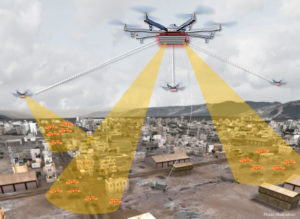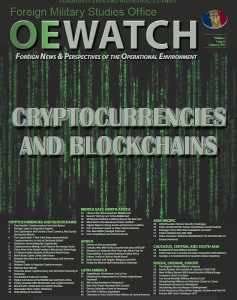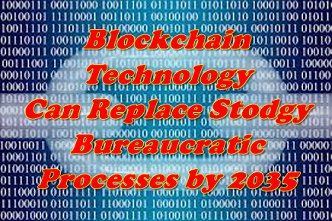[Editor’s Note: Mad Scientist Laboratory is pleased to welcome guest blogger LTC James Barnhart, whose post today explores the possible application of Blockchain technology to revolutionize military decision cycles via the use of Decentralized Autonomous Organizations (DAOs). This technology could shorten the Joint force’s response times during Multi-Domain Operations, enabling us to outpace our adversaries and win decisively. Blockchain technology, in conjunction with Artificial Intelligence, has the potential to accelerate our ability to “conduct independent maneuver, employ cross-domain fires, and maximize human potential,” while improving “human decision making in both speed and accuracy.” Read on!]
The Big Picture
 Blockchain technology has a purpose in establishing authorities and control over the use of emerging technologies as well as performing operational to strategic-level organizational tasks. Provided we have a knowledgeable and innovative workforce in the year 2035 (and beyond), Blockchain can be implemented to replace organizational boundaries in times of war. Imagine organizations using a Decentralized Autonomous Organization (DAO) that executes pre-determined authorities through Smart Contracts, programs that execute within a Blockchain between two or more nodes making a transaction.
Blockchain technology has a purpose in establishing authorities and control over the use of emerging technologies as well as performing operational to strategic-level organizational tasks. Provided we have a knowledgeable and innovative workforce in the year 2035 (and beyond), Blockchain can be implemented to replace organizational boundaries in times of war. Imagine organizations using a Decentralized Autonomous Organization (DAO) that executes pre-determined authorities through Smart Contracts, programs that execute within a Blockchain between two or more nodes making a transaction.  This could replace the physical middle-management office when deploying swarm technologies, calling for Joint-level fire support, opening ports in contested environments, or controlling ISR assets to support intelligence operations. The list of possible military applications goes on…. Establishing these pre-determined authorities through Smart Contracts has the potential to reduce coordination times among a myriad of organizations, increasing optimization and response times in All-domain operations (and Large Scale Combat Operations).
This could replace the physical middle-management office when deploying swarm technologies, calling for Joint-level fire support, opening ports in contested environments, or controlling ISR assets to support intelligence operations. The list of possible military applications goes on…. Establishing these pre-determined authorities through Smart Contracts has the potential to reduce coordination times among a myriad of organizations, increasing optimization and response times in All-domain operations (and Large Scale Combat Operations).
What is Blockchain Technology?
 Blockchain technology is a transactional protocol that emphasizes a peer-to-peer (P2P) decentralized computing infrastructure combining cryptography using hash algorithms and a digitized public ledger that removes the traditional physical middle-agents (i.e., banks, institutions, etc.) for conducting these transactions. In addition, it is an anonymized “trust” network that is built around encrypted algorithms. Each node within a Blockchain has a ledger, which is updated concurrently when executing a transaction. A Blockchain does not assume all nodes are trustworthy; rather, in order for a Smart Contract to be used, all nodes must achieve consensus digitally before executing (Antonopoulos & Wood, 2019; Norman, 2019; Werbach, 2018).
Blockchain technology is a transactional protocol that emphasizes a peer-to-peer (P2P) decentralized computing infrastructure combining cryptography using hash algorithms and a digitized public ledger that removes the traditional physical middle-agents (i.e., banks, institutions, etc.) for conducting these transactions. In addition, it is an anonymized “trust” network that is built around encrypted algorithms. Each node within a Blockchain has a ledger, which is updated concurrently when executing a transaction. A Blockchain does not assume all nodes are trustworthy; rather, in order for a Smart Contract to be used, all nodes must achieve consensus digitally before executing (Antonopoulos & Wood, 2019; Norman, 2019; Werbach, 2018).

There are four core value propositions behind Blockchain technology: (1) decentralized control; (2) a shared view of the truth; (3) collaboration across organizational boundaries; and (4) the direct exchange of value through tokens (Werbach, 2018). For the use within this context, I would like to focus your attention on the first three.
Each transaction uses “blocks” and “chains.” A block is “a collection of required information (a block header) about the comprised transactions, and a set of other block headers known as ommers” (Antonopoulos & Wood, 2019, p. xxv). According to Antonopoulos and Wood (2019), ommers are considered child blocks that are not in and of itself ancestor blocks. A chain is an interconnected system of blocks comprised of ancestors and ommers that enable trust to send and receive Cryptocurrency and leverage the use of Decentralized Applications (DApp) through the use of a DAO, a virtual environment that helps to establish Smart Contracts (Antonopoulos & Wood, 2019; Werbach, 2018).

What is a Smart Contract and how are they executed?
Smart Contracts are essentially programs that execute within a Blockchain between two or more nodes making a transaction. These contracts take the “place of law, intermediaries, and personal relationships as the foundation of trust” (Werbach, 2018, p. 67). Once a Smart Contract is executed, all nodes within that specific Blockchain are updated using concurrency. Concurrency, a computer science term, is when multiple computing nodes conduct decentralized and distributed real-time computations (Antonopoulos & Wood, 2019).
According to Werbach (2018), a DAO is a virtual business that serves as a connection of contracts within a Blockchain. These virtual autonomous business structures enhance the trust between the P2P decentralized infrastructure, replacing the physical corporate agreements and governance that are typically overseen by banks and institutions (Werbach, 2018).
Decentralized applications can help leaders make decisions and save time executing them
DApp, a web application similar to online banking, is composed of a Smart Contract and a web user interface that is built on top of a Blockchain (Antonopoulos & Wood, 2019).
In this post’s context, Smart Contracts alone are useless without DApps. Artificially Intelligent-enforced DApps can help gather data during a time of need, helping to develop the strategic situation and recommend execution of organizational authorities.
Operational Opportunities and Strategic Advantages
As we build a future force, it is imperative that we not only look at newer capabilities to implement, but that we comprehensively look at how quickly we can outpace our adversaries, creating operational opportunities and strategic advantages using them. In order to enhance vital transactions that would require relational authorities between command structures, service components, and special mission units, Blockchain technology seems to be a possible solution.

Using Smart Contracts established through DAOs at the DOD- and Joint-levels, we will be able to establish existing relationships digitally using Blockchain technology and execute transactions with relation to the tempo of the  battlefield in times of war. The use of Smart Contracts and DOAs can help deploy and sustain swarm technologies in support of operations, call for Joint-level fire support, open ports in contested environments, or control satellites to support intelligence operations.
battlefield in times of war. The use of Smart Contracts and DOAs can help deploy and sustain swarm technologies in support of operations, call for Joint-level fire support, open ports in contested environments, or control satellites to support intelligence operations.
Collectively, the features within Blockchain technologies can enhance our leaders’ ability to assess and execute vital decisions by easily traversing pre-determined Smart Contracts. These Smart Contracts can be leveraged using machine learning algorithms that help provide options at the time of need. Connecting Blockchain technologies to knowledge management systems via machine learning algorithms is an essential capability for our future force.
 For a deeper dive into this topic, go to the TRADOC G-2’s Foreign Military Studies Office (FMSO) OEWatch page and download Volume 8, Issue #1, January 2018, featuring a host of articles on Cryptocurrencies and Blockchains and their impact in nations around the world…
For a deeper dive into this topic, go to the TRADOC G-2’s Foreign Military Studies Office (FMSO) OEWatch page and download Volume 8, Issue #1, January 2018, featuring a host of articles on Cryptocurrencies and Blockchains and their impact in nations around the world…
… check out Dr. Mica Hall‘s two posts — Weaponizing an Economy: The Cryptoruble and Russia’s Dystopian Future and The Cryptoruble as a Stepping Stone to Digital Sovereignty…
… and explore these related posts:
Integrating Artificial Intelligence into Military Operations, by Dr. James Mancillas, as well as his complete report here
LTC James Barnhart leads the Models and Simulation Support Team at the Sustainment Battle Lab, Fort Lee, VA as the Senior Technical Manager. On his own time, he enjoys programming as well as conducting science and technology research.
Disclaimer: All views expressed in this post are the author’s and do not necessarily reflect those of the Department of Defense, Department of the Army, Army Futures Command (AFC), or Training and Doctrine Command (TRADOC).
References
Antonopoulos, A. M., & Wood, G. (2019). Mastering Ethereum: Building Smart Contracts and DAPPS. Sebastopol, CA: O’Reilly.
Norman, A. T. (2017). Blockchain Technology Explained. Monee, IL: Amazon.
Werbach, K. (2018). The Blockchain and the New Architecture of Trust. Cambridge, MA: The MIT Press.



